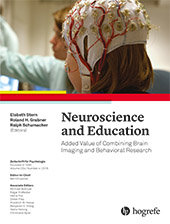What are the Benefits and Potential Problems of Jointly Considering Neurophysiological and Behavioral Data in Dyslexia Intervention Research?
Commentary on Bédard, Laplante, and Mercier (2016)
References
(2016). Development of reading remediation for dyslexic individuals: Added benefits of the joint consideration of neurophysiological and behavioral data. Zeitschrift für Psychologie, 224, 240–246. doi: 10.1027/2151-2604/a000259
(2004). Developmental dyslexia and specific language impairment: Same or different? Psychological Bulletin, 130, 858–886. doi: 10.1037/0033-2909.130.6.858
(1995).
Causal modelling: A structural approach to developmental psychopathology . In D. CicchettiD. J. CohenEds., Developmental psychopathology (Volume 1: Theory and methods (pp. 357–390). New York, NY: Wiley.(2006). Neural mechanisms in dyslexia. Current Directions in Psychological Sciences, 15, 278–281. doi: 10.1111/j.1467-8721.2006.00452.x
(2004). Development of left occipito-temporal systems for skilled reading in children after a phonologically-based intervention. Biological Psychiatry, 55, 926–933. doi: 10.1016/j.biopsych.2003.12.019



